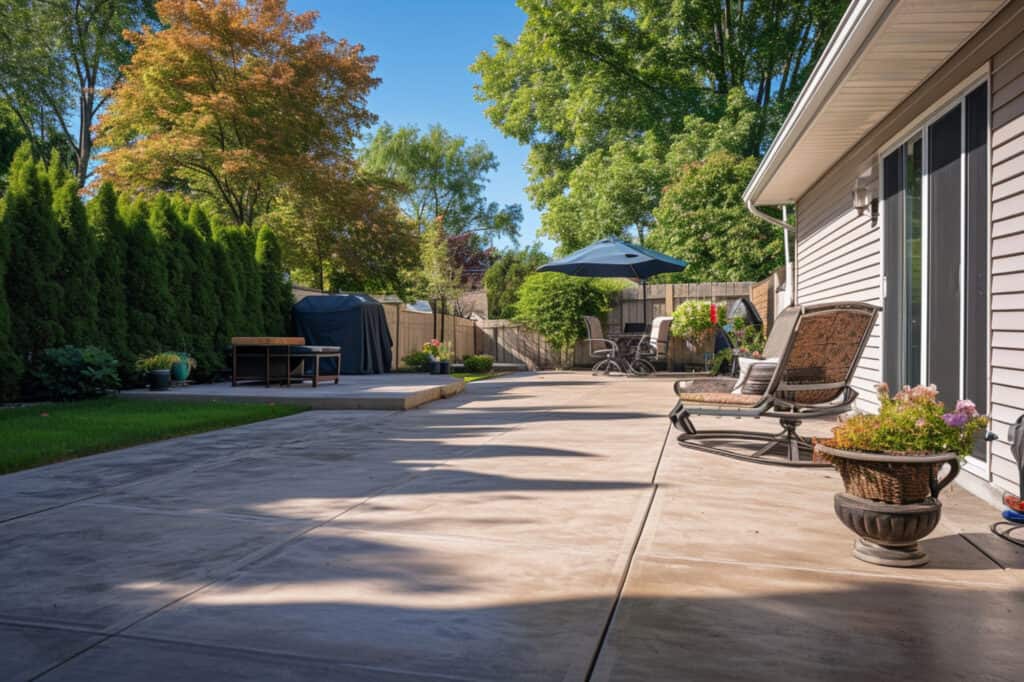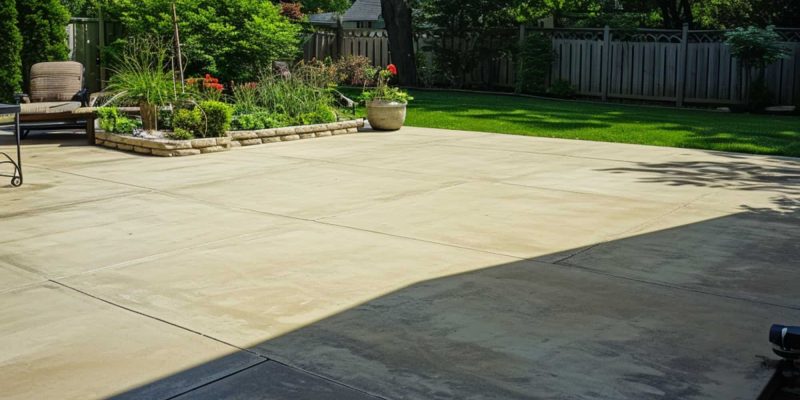While these stains may seem daunting, they’re not a life sentence for your patio. With the correct approach, you can effectively remove them, restoring your patio’s aesthetic appeal and ensuring its longevity. So, let’s embark on this journey to reclaim the pristine condition of your outdoor space.
Understanding Different Types of Patio Stains
In the world of concrete patios, not all stains are created equal. They come from various sources and thus, require tailored removal strategies.
Oil and Grease Stains
Oil and grease stains commonly originate from everyday patio activities, such as cars parked on the driveway, grilling, and the occasional food spill. These stains are easily recognizable by their dark, slick appearance, indicating their ability to deeply penetrate the concrete’s surface. The removal of these stains poses a challenge due to their tendency to seep into the porous material of the concrete, requiring robust and effective cleaning agents for successful eradication.
Rust Stains
Rust stains on patios often source from metal furniture or tools left exposed, especially during Joliet’s rainy spells or wet conditions. These stains may not be immediately apparent, as they tend to appear as subtle, yet persistent marks. Over time, without proper attention, they can become more pronounced and difficult to remove. The approach to removing rust stains involves specific treatments that are capable of targeting the chemical composition of rust, ensuring that the stains are effectively lifted without damaging the concrete.
Organic Stains
Organic stains on concrete patios arise from natural materials like fallen leaves, berries, or accidental spills from garden products. These stains present themselves as dark spots or discolored patches on the concrete, with their intensity varying based on the material and the length of time they have been left unaddressed. The strategy for cleaning organic stains often requires a gentler approach compared to chemical stains, yet it demands immediate action. Prompt removal is key to preventing these natural substances from setting into the concrete and causing long-term discoloration.
NOTE
Each type of stain presents a unique challenge on concrete patios, demanding specific strategies for effective removal. Understanding the source and characteristics of these stains is crucial in choosing the right cleaning methods to restore the patio’s appearance.
Preparing Your Patio for Stain Removal
- Conduct a Thorough Inspection – Begin your patio maintenance by conducting a detailed inspection of the entire area. Look carefully for any signs of wear, such as cracks, chips, or areas showing signs of erosion in the concrete. This step is essential, as these issues can affect the effectiveness of the cleaning agents and may worsen if not addressed before cleaning. Identifying these problems early on ensures that you can take the necessary steps to prevent further damage during the cleaning process.
- Repair Any Damage – Once any damage has been identified, it’s important to address it promptly. For small cracks and chips, use a suitable concrete filler or sealer. Follow the product’s instructions carefully, especially regarding application methods and drying times. Filling and sealing these areas help prevent water and cleaning solutions from seeping into the concrete, which could lead to more significant damage.
- Identify the Types of Stains– Before you start the cleaning process, determine the types of stains present on your patio. Whether they are oil, grease, rust, or organic stains, each type requires a specific approach for removal. Identifying the nature of each stain will guide you in selecting the most appropriate cleaning solutions and methods for effective removal.
- Clear the Patio Area – The next step involves clearing the patio area of all movable objects. This includes planters, furniture, grills, and any decorative items. Removing these items ensures that you have unobstructed access to the entire patio surface, making it easier to thoroughly clean and treat stains. Additionally, clearing the area protects your belongings from potential damage caused by cleaning agents or tools used during the process.
- Sweep the Patio – After clearing the area, thoroughly sweep the entire patio. Use a sturdy broom to remove all loose dirt, leaves, and other debris. This step is crucial for ensuring that the surface is free from any materials that could hinder the cleaning process. Pay special attention to corners and edges where debris tends to accumulate. A clean surface allows for more effective application of cleaning solutions and stain removal treatments.
- Rinse the Patio Surface – Once sweeping is complete, proceed to rinse the patio with water. This can be done using a garden hose or a bucket of water. Rinsing helps to further remove any remaining surface dirt and preps the concrete for the stain removal treatments. Ensure that the entire surface is evenly wetted, but avoid creating pools of water, as this can make the area slippery and harder to work on.
Easy Steps for DIY Solutions in Stain Removal

Embarking on DIY solutions for stain removal can be a straightforward and effective way to maintain the beauty of your patio. Here are some easy steps that homeowners can follow to tackle different types of stains using simple, readily available products.
Removing Oil and Grease Stains
- Prepare Cleaning Solution
- Mix a generous amount of dish soap with warm water. This solution is effective in breaking down oil and grease.
- The warm water helps to dissolve the soap quickly, creating a powerful cleaning mixture.
- Apply Absorbent (For Stubborn Stains)
- For tougher stains, sprinkle baking soda or cornstarch over the area before applying the soap solution.
- These substances absorb excess grease, making the subsequent cleaning process more efficient.
- Scrub the Stain
- Use a stiff brush to vigorously scrub the stained area with the soap solution.
- The stiff bristles of the brush help to agitate and lift the grease from the concrete’s pores.
- Rinse Thoroughly
- After scrubbing, rinse the area thoroughly with water.
- Ensure that all soap residue is washed away, as leftover soap can attract more dirt.
Removing Rust Stains
- Apply Natural Acid
- Lemon juice or white vinegar are effective natural acids for rust removal.
- Apply either directly to the rust stain, ensuring the area is fully covered.
- Allow Time to React
- Let the acid sit on the stain for about ten minutes.
- This duration allows the acid to break down the rust compounds.
- 3. Scrub the Area
- After letting it sit, scrub the area with a brush or sponge.
- The scrubbing action, combined with the acid, helps to lift the rust stain from the concrete.
- Rinse Off the Area
- Rinse the area well with water to remove any remaining acid and rust residue.
Removing Organic Stains
- Boil Water (For Lighter Stains)
- For less severe organic stains, boiling water can be surprisingly effective.
- Pour boiling water directly onto the stain, which helps to loosen and lift the organic material.
- Create Baking Soda Paste (For Tougher Stains)
- Mix baking soda with water to form a paste for more stubborn stains.
- Apply this paste to the stain and let it dry completely.
- Scrub and Rinse
- Once the paste is dry, scrub the area with a brush.
- Rinse the area thoroughly with water to remove the baking soda and lifted stain.
Advanced Stain Removal Techniques
When DIY solutions fall short, it’s time to consider professional-grade products. Stains that persist after several attempts with home remedies may require a stronger approach. Commercial degreasers and concrete-specific cleaners are formulated to tackle tough stains without damaging the patio. However, when using these potent chemicals, safety becomes paramount. Always wear protective gear, such as gloves and safety glasses, and ensure you’re working in a well-ventilated area to avoid inhaling fumes. Following the product’s instructions to the letter is crucial for both effectiveness and safety. Additionally, being mindful of the environment, try to prevent runoff from chemical cleaners from contaminating your garden or local waterways.
Preventive Measures for Future Stains
The most effective way to deal with patio stains is to prevent them from happening in the first place. Proactive measures and a consistent care routine are key to keeping your patio in pristine condition, avoiding the need for extensive cleaning or stain removal in the future.
Regular Maintenance
- Perform routine sweeping to remove dirt and debris.
- Occasionally rinse the patio to clear away any residue.
- Regular upkeep helps in maintaining a clean surface, reducing the likelihood of stains setting in.
Immediate Response to Spills
- Address spills as soon as they happen.
- Quick action prevents spills from turning into permanent stains.
Applying Concrete Sealant
- Use a sealant to create a protective barrier against future stains.
- Ensure the sealant is suitable for outdoor use and compatible with concrete.
- Reapply the sealant every few years to maintain its effectiveness.
Choosing the Right Sealant
- Select a sealant that specifically states its suitability for use on concrete patios.
- Consider environmental factors and usage patterns in your selection.
Periodic Reapplication of Sealant:
- Reapply the sealant at regular intervals (every few years) based on the manufacturer’s recommendation and wear and tear.
- Regular reapplication ensures continuous protection against stains and environmental elements.
Adapting to Changing Seasons
The care your patio requires can vary with the seasons, particularly in a place like Joliet with its distinct seasonal changes. Spring cleaning to remove winter’s salt and debris sets the stage for summer, when regular sweeping and spot cleaning become routine. Fall brings its own challenges, with leaves and organic debris requiring prompt removal to prevent staining. Winterizing your patio by ensuring it’s clean and sealed before the freeze can prevent ice and snow from causing damage. Adjusting your maintenance routine with the seasons ensures your patio remains in top condition throughout the year.
Conclusion
Taking care of your concrete patio doesn’t have to be a daunting task. With the right knowledge and tools, you can effectively remove any stains and prevent new ones from forming. Regular maintenance and a proactive approach to spills and seasonal changes can keep your patio looking its best. Remember, a little effort goes a long way in preserving the beauty and longevity of your outdoor space. So roll up your sleeves and give your patio the care it deserves. Your outdoor gatherings will be all the better for it.

